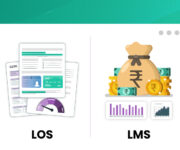The right Loan Management System (LMS) often dictates lenders’ operational efficiency, compliance, and ability to scale. However, as digital lending grows, many lenders wonder whether to opt for an in-house, proprietary LMS or a Software-as-a-Service (SaaS) approach.
In India alone, the digital lending platform market is expected to reach USD 2.38 billion by 2030, growing at a compound annual growth rate (CAGR) of 30.2% from 2025 to 2030.
Thus, making the right choice regarding the Loan Management System is crucial for lenders seeking to remain competitive in an ever-evolving lending landscape. Let’s compare both models in depth to determine which method delivers more sustainable value over time.
Proprietary and SaaS-based Loan Management System: A Quick Look
While both proprietary and SaaS-based LMS handle the complete loan lifecycle from origination to closure, they represent fundamentally different approaches to software ownership and delivery.
1. Proprietary (In-House) LMS
As noted, a proprietary LMS is custom-built software developed and owned entirely by the lending institution. The lender controls every aspect of the system, from the underlying code to the hosting infrastructure.
Lender Profiles & Typical Use Cases
This approach typically appeals to large banks with substantial IT budgets and complex legacy integrations.
Specialised lenders offering unique products (like equipment financing or trade finance) also gravitate towards proprietary systems, as do organisations with strict data sovereignty requirements or those operating in highly regulated niches.
Decision-Making Framework
Given the significant investment involved, these organisations typically approach LMS selection through senior technology leadership, compliance teams, and board-level approval processes.
Their decision framework weighs available IT talent, regulatory constraints, competitive differentiation needs, and long-term technology strategy alignment against the substantial capital requirements.
2. SaaS-Based LMS
A SaaS-based Loan Management System takes a markedly different approach, delivering pre-built software through the cloud on a subscription basis.
The vendor owns, maintains, and continually updates the platform, which multiple lenders access as a shared service.
Lender Profiles & Typical Use Cases
This model particularly attracts emerging fintechs, NBFCs seeking rapid market entry, and traditional lenders expanding into digital channels. Organisations with limited IT resources, those prioritising speed-to-market, or lenders focusing on standard retail/SME products find SaaS platforms align well with their operational needs and resource constraints.
Decision-Making Framework
The decision-making process here involves different stakeholders and criteria. Product managers, operations heads, and finance teams typically lead evaluations, focusing on ROI and operational efficiency rather than technical control.
Proprietary vs SaaS Loan Management System: A Strategic Comparison
Now, let’s analyse how both loan management systems compare across key business parameters:
1. Cost and Time to Deploy
Proprietary LMS:
An in-house system means high capital investment. Starting from software developers and UI/UX designers to recurrent QA, security, and infrastructure maintenance, the expenses often continue to rise.
Plus, deployment cycles can take anywhere from 6 months to 2 years, depending on the complexity.
SaaS-Based LMS:
On the other hand, SaaS offerings are subscription-based with assured operating costs and low upfront investment. Deployment is rapid, occurring in a matter of weeks, and updates are performed automatically.
This makes it easier for fintechs and NBFCs to go live fast and remain up-to-date.
2. Regulatory and Compliance Readiness
Proprietary LMS:
Custom-built systems often struggle to keep pace with evolving regulations such as RBI’s digital lending guidelines, KYC norms, or data localisation mandates.
Any regulatory update may require substantial code changes and audits.
SaaS-Based LMS:
SaaS providers invest in maintaining compliance features, including audit logs, secure data storage, and auto-updates in response to new regulations.
This ensures real-time alignment with statutory norms.
3. Scalability and Performance
Proprietary LMS:
Scaling a proprietary solution often means re-architecting systems to support higher load or new products. Performance tuning and server provisioning fall on internal teams, which may delay market response.
SaaS-Based LMS:
Cloud-native SaaS is built for scalability. Whether you’re expanding into new geographies or launching new credit lines, scaling is fast and frequently automated. You pay as you scale.
4. Feature Updates and Innovation
Proprietary LMS:
Any new feature or compliance update must be designed, coded, tested, and deployed manually. Innovation cycles can be slow without a dedicated R&D team.
SaaS-Based LMS:
With shared infrastructure and customer feedback loops, SaaS vendors constantly push new features. Customers benefit from quicker access to innovations like AI-driven underwriting, predictive analytics, and API integrations.
5. Integration with External Ecosystems
Proprietary LMS:
Integrating with systems such as credit bureaus, PAN/Aadhaar verification, GSTN, or bank statement analytics may require custom APIs and security checks. Each new integration increases development overhead.
SaaS-Based LMS:
Most SaaS LMSs are pre-integrated with a vast majority of third-party data sources, making credit assessment and compliance simpler. API marketplaces or plug-ins are available for quick onboarding.
6. Data Security and Control
Proprietary LMS:
Provides absolute data ownership. Lenders have control over where data is hosted, how it’s encrypted, and who can access it.
However, this also makes them fully responsible for security protocols and disaster recovery.
SaaS-Based LMS:
Trusted SaaS providers adhere to international security standards such as ISO 27001 or SOC 2. They provide encryption, role-based access, and data recovery.
But lenders must make sure that the vendor’s hosting and compliance standards meet their requirements.
7. Long-Term Sustainability
Proprietary LMS:
At first, it offers deep control, but eventually can become obsolete without continued investment. High technical debt, lack of agility, or outdated frameworks can affect sustainability.
SaaS-Based LMS:
Keeps improving with each release, and usually, no additional cost is involved. As lending models advance (BNPL, co-lending, embedded credit), SaaS platforms keep pace, providing longevity and adaptability.
Key Takeaway
Flexibility, speed, and compliance are non-negotiables in the dynamic lending landscape. A proprietary LMS offers control, but at the cost of scalability and resource dependency. In contrast, a SaaS-based LMS provides cost-effectiveness, quicker innovation, and pre-built integrations that provide lenders with a competitive advantage.
Finezza’s Loan Management System is designed specifically for modern lenders with:
- Cloud-native scalability for growing loan volumes
- Seamless API integrations with credit bureaus, KYC platforms, and PAN/GST databases
- Automated EMI tracking, NPA detection, and audit logging
- Built-in reporting for RBI compliance
Book a demo today to explore how Finezza’s LMS simplifies lending operations and drives long-term ROI.




Leave a Reply